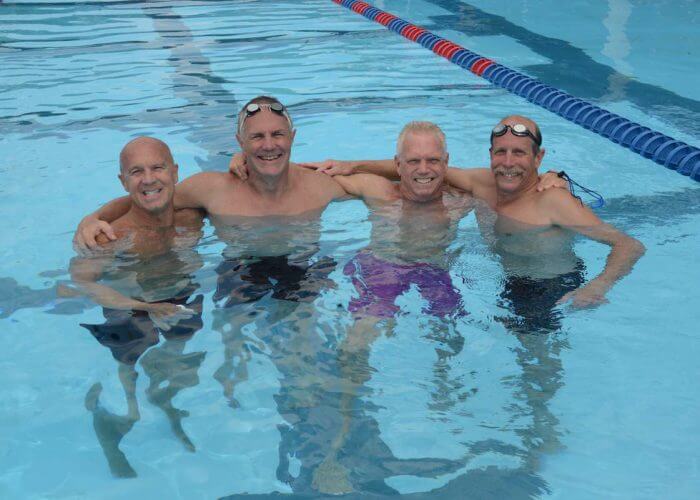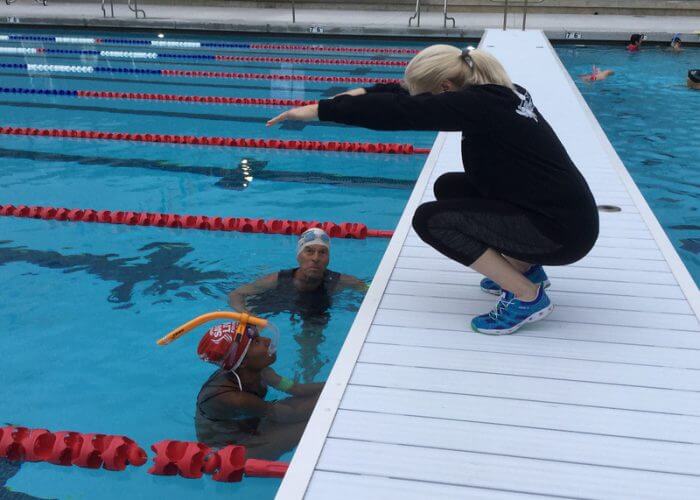Coaching Masters Swimming: A Different Sport With Many Needs to Meet

Coaching Masters Swimming: A Different Sport With Many Needs to Meet
(From the Archive)
Commentary by Jason Tillotson
When we think of swimmers and the American swimming community, we think of early morning practices, a full day of school or work then a return to the Olympic-sized ice box for an afternoon dip. Even those outside of the swimming community know how grueling and time-consuming a sport like swimming is.
We often forget that those long, early hours and strenuous training schedules aren’t only followed by young, high school aged athletes but also by the more seasoned veterans of the sport. United States Master’s Swimming shares the “early-birdness” aspect of the sport but could not be more different in terms of what athletes do once they dive in.
When talking about swimming, it is important to think of each athlete as just that: An athlete, not a swimmer. The difference is minimal in conversation but in practice, a member of any team, whether it be USMS or USA Swimming, should be considered and referred to as an “athlete” because their life experience shapes them into a more whole individual, not just a swimmer. This is especially true with USMS athletes.

Photo Courtesy: Rick Walker
In other words, swimming is often a small part of a Masters athlete’s day, but a large part of their lives. For coaches, this means you only have about an hour early in the morning or very late at night to make these athletes better in a way they want to be for their own individual goals. This is unequivocally different than coaching a USA Swimming club because, regardless of the individual goals of each athlete, a coach must attempt to get everyone, collectively, on the same boat to embark on a journey to collective, and simultaneously, individual success.
For example, a USA Swimming age-group club coach might be trying to get their 15-and-overs to hold 58s or better on a set of 30x100s @ 1:30 best average, so that the overall aerobic fitness of that group gets better over time. Or an 8-and-under coach may be reinforcing streamline position so that the technique of the group improves in order to set the collective group up for success when they graduate to the 10-and-over training group. This concept does not exist as much in USMS swimming.
Any given Masters training group is an eclectic mix of people from many different skill levels, all with different years of experience. Being a coach, this makes for a challenge when writing and orchestrating workouts especially when attempting to consider the goals of each individual athlete.

Photo Courtesy: Cokie Lepinski Photography
The day before coaching my first training session with Lane4 Swimming, a USMS club in Washington, D.C., I had begun drafting a workout I thought would be doable for almost everyone I would see in the tank the next morning. My process, at first, was simple. I began by sifting through old workouts I had created, seen or done myself until I found one I could use as a block from which I would chisel my masterpiece. I started chopping distances in half and doubling intervals, adding some pull sets, taking away kick sets (I have come to find USMS athletes are not too fond of kicking).
I would arrive at the pool well before 6:00 a.m. and began writing on the white board what the warmup was going to be for that day. Within a minute, after all the athletes had begun swimming, it was clear some changes were necessary. The possibility of coaching people well into their 50s and 60s, with only a small amount of swimming experience, was clearly overlooked.
A majority of the athletes were perfectly capable of doing my workout and found it to be challenging, yet doable, as intended. But what about the woman who just began swimming for the first time six months ago and was never taught how to rotate in freestyle? What about the man who’s been out of the pool for a year and half after a shoulder surgery? And the woman who just asks for any version of 4,000 yards each morning? Or, what about the retired 2016 Olympian who is just swimming for fitness? Was my workout helping each of those swimmers, as well as everyone else in the pool, achieve their goals? As a coach, no athlete should be left to escape your subconscious attention during a workout, and no athlete deserves to be left by the wayside while the rest of the group continues on.
This is part of what makes coaching USMS so challenging, there are so many different levels in the pool at once, it can become overwhelming to try and keep track of them all. A daunting task, but an essential one. On that day, it was apparent not everyone was suited to go four rounds of 1×300, 2×200 and 3×100 on a 1:30 or 1:45 base interval.
That day, I immediately assessed what went wrong and began drafting a new plan for the next workout, one that would be much more successful. After a 1,600-yard warmup consisting of some swimming, kicking, drilling and speed work the athletes got to choose from four different options, each with a different focus and geared towards different goals each athlete might have. Many of the athletes in the pool that day were training for an open water swim in the Chesapeake Bay in June or Masters Open Water Nationals in May, so many of them chose one of the longer, more aerobic options, which tends to be a popular option for many USMS swimmers.

Photo Courtesy: Jason Tillotson
Giving them these options allowed for the Olympian in the group to do what she needed to do in order to meet her goals and gave the novice level swimmers a chance to pick something they needed work on, or ask me for advice as to which option would be the best for them. If the athletes had been given only one option, many of them would have slipped through the cracks and would not have gotten what they needed to, out of the workout.
In USMS swimming, choices should be offered for that very purpose, so that the goals for each individual swimmer can be met to ensure the success of the individual, not the collective. Choices should be laid out in detailed, explicit and clear form so that each piece is easily comprehensible. In the workout above, the time each set takes, along with the total yardage is written near each option so that an athlete who is on a time crunch, or who needs to meet a certain amount of yards for the week, can keep track of how long each set is and choose accordingly.
Masters swimming is unique in the sense that it requires a much different approach from coaching a club, high school or college team. That difference is what makes coaching USMS so enjoyable because one can teach a beginner-level swimmer how to engage their core in freestyle, help a long retired collegiate all-star get back in shape after surgery and help set the open water swimmers up for success at the national level, all in the same hour, often times before the sun even comes up.
All commentaries are the opinion of the author and do not necessarily reflect the views of Swimming World Magazine nor its staff.




Excellent advice! We’ll have to try it out with our Masters!
Thank you for reading! Glad you enjoyed!
Great artickd! I shared it. Masters is my fav group to coach and it is nice to see someone else recognize the differences between masters and age group training. Fantastic job in this article.
Thanks, Yvette! Masters is my favorite group to coach right now too! Thanks for the share!
NIce insights for all aged early birds in the pool. Looks like things are everywhere similar around the globe.
Who doesn’t like kick sets? Let me put on my DMC Elite fins and I can dolphin kick on my back LCM all day. Or UDK on my front no breaths SCY.
Kicking sans fins is OK, too. No kickboard necessary!
Great advice. With master’s there are so many levels of ability, skill and goals in the water that it is often tough to make a single workout work for each one. I’ve found that the workout can be largely “the same”, but with adjustments for pace, focus and distance at almost every lane. A set that goes 6x {the set} with some tuff intervals and send-offs becomes a set 3x [} with a change in focus to be perfect swimming and/or drill combos. I actually love the challenge of Masters, as I get to stay engaged throughout the workout, working on strojes, technique, fitness goals and challenging the capabilities of athletes, all in a single practice ..